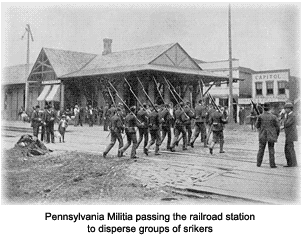The Homestead Strike of 1892 was one of the most bitterly fought industrial disputes in the history of U.S. labor. The Homestead Steel Works, located southeast of Pittsburgh, was an important segment of ^Andrew Carnegie^'s empire. Management and labor had been locked in negotiations for several months when plant general manager Henry C. Frick announced wage cuts of nearly 20 percent. The union balked at the reductions and Frick closed the plant on June 30.
 On July 6, the displaced workers opened fire on a barge loaded with 300 Pinkerton agents who were being brought in as strikebreakers. A battle raged for several hours. Three Pinkerton agents and seven strikers (or their supporters) were killed; later, several other men died from their wounds.
The workers initially thought they had won a great victory since the management forces had to withdraw. In fact, the Homestead strike was a total defeat for the workers and unionism as a whole.
The governor of Pennsylvania called out the state militia to enable management to regain control of the area. The Homestead plant was reopened to non-union workers, but wages were cut beyond the earlier proposal and the work day was lengthened. The union continued the strike until November, when they capitulated. Many strikers were blacklisted, which prevented them from regaining employment as steelworkers elsewhere.
After the Homestead Strike, steelworkers would remain largely devoid of union protections until the rebirth of labor activism in the 1930s.
On July 6, the displaced workers opened fire on a barge loaded with 300 Pinkerton agents who were being brought in as strikebreakers. A battle raged for several hours. Three Pinkerton agents and seven strikers (or their supporters) were killed; later, several other men died from their wounds.
The workers initially thought they had won a great victory since the management forces had to withdraw. In fact, the Homestead strike was a total defeat for the workers and unionism as a whole.
The governor of Pennsylvania called out the state militia to enable management to regain control of the area. The Homestead plant was reopened to non-union workers, but wages were cut beyond the earlier proposal and the work day was lengthened. The union continued the strike until November, when they capitulated. Many strikers were blacklisted, which prevented them from regaining employment as steelworkers elsewhere.
After the Homestead Strike, steelworkers would remain largely devoid of union protections until the rebirth of labor activism in the 1930s.